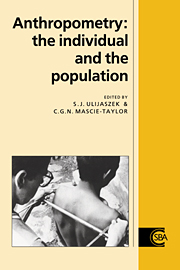Book contents
- Frontmatter
- Contents
- List of contributors
- Preface
- Acknowledgements
- 1 The place of anthropometry in human biology
- 2 Asymmetry and growth
- 3 Intra- and inter-observer error in anthropometric measurement
- 4 Statistical issues in anthropometry
- 5 Statistical constructs of human growth: new growth charts for old
- 6 Growth monitoring and growth cyclicities in developed countries
- 7 Growth monitoring, screening and surveillance in developing countries
- 8 Variability in adult body size: uses in defining the limits of human survival
- 9 Anthropometry and body composition
- 10 Anthropometry and physical performance
- 11 Anthropometry, strength and motor fitness
- 12 Anthropometry in the US armed forces
- Index
10 - Anthropometry and physical performance
Published online by Cambridge University Press: 19 November 2009
- Frontmatter
- Contents
- List of contributors
- Preface
- Acknowledgements
- 1 The place of anthropometry in human biology
- 2 Asymmetry and growth
- 3 Intra- and inter-observer error in anthropometric measurement
- 4 Statistical issues in anthropometry
- 5 Statistical constructs of human growth: new growth charts for old
- 6 Growth monitoring and growth cyclicities in developed countries
- 7 Growth monitoring, screening and surveillance in developing countries
- 8 Variability in adult body size: uses in defining the limits of human survival
- 9 Anthropometry and body composition
- 10 Anthropometry and physical performance
- 11 Anthropometry, strength and motor fitness
- 12 Anthropometry in the US armed forces
- Index
Summary
Introduction
This chapter examines the extent to which body size, shape and composition determine or correlate with indices of physical performance. Although a relationship between size and performance is obvious and well documented, performance is influenced by a multitude of other factors which may confound or obscure the simple relationship such that the correlation is, at best, weak. It begins with a statement of what is understood by the term anthropometry and a description of the different types of physical performance and the factors affecting them. The theoretical relationships are summarized and then the empirical evidence relating performance to anthropometric indices is reviewed.
Anthropometry
Anthropometry means, literally, the measurement of people; taken literally, it could include any human characteristic including, for example, intelligence. Indeed, Stephen Jay Gould's provocative and highly readable book The Mismeasure of Man (Gould, 1984) is mainly concerned with psychological characteristics. But anthropometry has come to be used in a more restrictive sense to mean the comparative study of sizes and proportions of the human body. Here, anthropometry is considered to include size and shape (the proportionality of sizes) and the composition of the body (the masses and proportions of its constituents). These are commonly described, in the first instance, in anatomical terms as lean body mass (LBM) and adipose tissue (AT) or the similar but not identical chemical model of the body as fat-free mass (FFM) and fat mass (FM). It is both legitimate and more informative to include these, or, say, skeletal muscle mass than to consider height, weight and shape indices alone.
- Type
- Chapter
- Information
- AnthropometryThe Individual and the Population, pp. 141 - 159Publisher: Cambridge University PressPrint publication year: 1994
- 2
- Cited by



